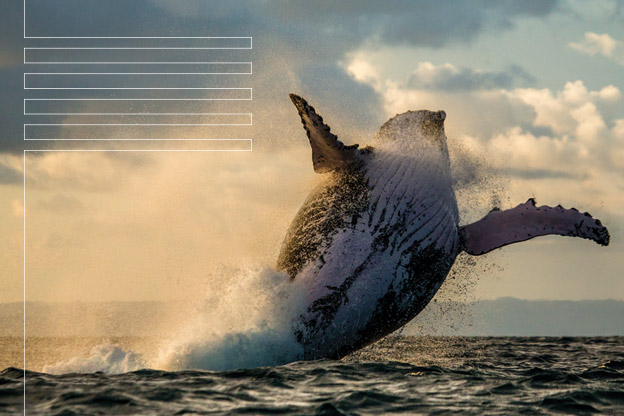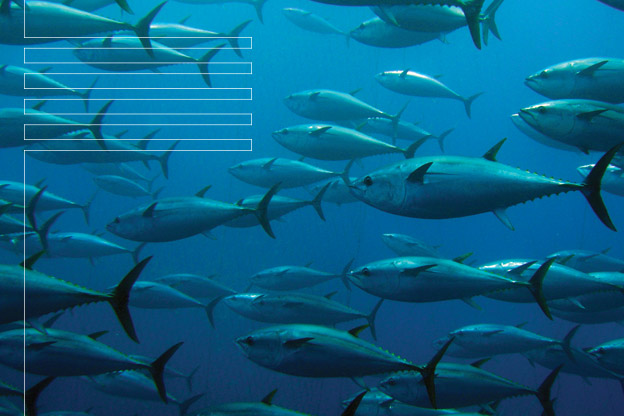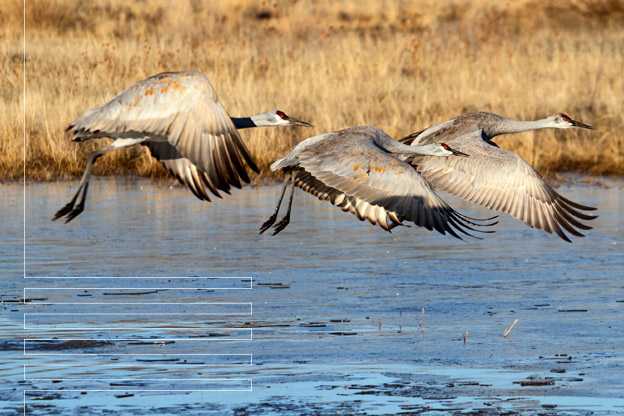 Around the world, animals participate in mass migrations that have existed for thousands of years. Many of these migrations are Olympic-worthy, long-distance feats of physical prowess, covering several hundred, sometimes thousands, of miles every year, often with barely any feeding along the way. There’s the great caribou migration of the far north, in which large herds of caribou will travel as a single group across northern Alaska. There’s the Arctic tern, which holds the record for the longest migration of any animal — 44,000 miles between the Arctic and the Antarctic. There’s the peculiar migration of the Christmas Island red crab, in which thousands of these crabs migrate from their terrestrial burrows to the coast to breed. And there are animals right here in Pacific Northwest waters that participate in their own amazing long-distance journeys.
Around the world, animals participate in mass migrations that have existed for thousands of years. Many of these migrations are Olympic-worthy, long-distance feats of physical prowess, covering several hundred, sometimes thousands, of miles every year, often with barely any feeding along the way. There’s the great caribou migration of the far north, in which large herds of caribou will travel as a single group across northern Alaska. There’s the Arctic tern, which holds the record for the longest migration of any animal — 44,000 miles between the Arctic and the Antarctic. There’s the peculiar migration of the Christmas Island red crab, in which thousands of these crabs migrate from their terrestrial burrows to the coast to breed. And there are animals right here in Pacific Northwest waters that participate in their own amazing long-distance journeys.
Like the many spring and summer tourists that visit the Pacific Northwest, British Columbia, and Alaska, many kinds of animals make their rounds on local waters to the delight of boaters who witness them. The warm, sunny weather and calmer waters make it an optimal time to get out and see transient fauna that call the North Pacific home for only part of the year, so now is the time to slap on some sunscreen, grab your binoculars, and head out on a boat!

But first, what is the definition of a migration? As defined in a scientific paper by two marine mammal scientists, Peter J. Corkeron and Richard C. Connor, “migration involves persistent movement between two destinations.” There is often an associated pattern, either by time of year, stage of life, and especially the destination. Many different types of animals migrate, including fish, mammals, and birds.
To take an even further step back, why do animals migrate in the first place? This is a question that is not quite as straightforward as one would think. For example, let’s take a look at whales. Many migrations exist between breeding and feeding grounds, with the apparent strategy being that breeding grounds typically exist in cold, nutrient-rich water that supports a larger amount of lower trophic level organisms, such as plankton and schooling species of fish, and that breeding grounds exist in warm waters so that young can build up fat reserves in warm, calm water before venturing to higher latitudes. Many species of whale utilize this strategy, such as humpbacks migrating from their breeding grounds in the warm waters of Hawaii to their feeding areas in Alaska.
Migrations, however, are energetically costly. For scientists, it makes sense that animals would migrate to areas dense in nutrient-rich waters — the energetic payoff is a net benefit. The other side of the story — travelling to warm, nutrient-poor waters for breeding and birthing — leaves some scientists scratching their heads. Is the energetic payoff still a net benefit for the individual animal?
One hypothesis to explain this behavior in whales is that during the winter months in colder waters, food sources become scarce, and so there is an overall energetic advantage to travel to warmer water. Basically, staying in colder waters does not provide enough food for it to be beneficial to the animal, so they may as well travel to warmer, more protected waters to give their young the best head start in life.
In a 1999 paper by Corkeron and Connor, titled Why Do Baleen Whales Migrate?, the authors’ hypothesis is that baleen whales, such as humpbacks, give birth in warmer regions not because of warmer, calmer waters for their calves, but because they are trying to avoid the number one predator to a young calf — killer whales. Killer whale predation in lower latitudes is significantly lower than in higher latitudes, and so there may be a net benefit in allowing the young, vulnerable calf to grow and gain strength before being at more risk in colder water.
Why don’t the killer whales just follow them? Corkeron and Connor suggest another hypothesis that if killer whales were to follow humpbacks, it may remove them from their primary source of food, which are seals and sea lions, also known as pinnipeds (on a side note, these orcas are specifically referred to as transient orcas, which live offshore and primarily feed on marine mammals, in contrast to resident orcas, which live nearshore and primarily feed on fish, such as the orcas of Puget Sound). While these transient orcas may go after a young humpback calf from time to time, the majority of their diet is seals and sea lions, and so it is not worth it for the orca to follow the humpbacks to Hawaii.
A final theory is something akin to traditional knowledge, and this is yet another idea that marine mammal scientists have as to why some species migrate. They think that migratory patterns have been passed down from long ago, when continents were closer together. The fact that some species of whales do not migrate every year, or even only complete a partial migration, leads scientists to think that this is not the case, and so is probably more related to some immediate biological benefit to the animal.
All these examples from whales highlight some of the potential reasons that organisms may choose to participate in a migration. There are several marine animals that locals are familiar with in the Pacific Northwest that have migration as part of their life history.
Gray whales have one of the longest migration of any mammal on earth, about 10,000 miles in two to three months. Every year, they travel between their breeding grounds in Mexico to the cold waters of Alaska and the Arctic. Gray whales give birth to their young during the spring months down south, and are seen travelling northward between January and June. They are found in the Pacific Northwest in the spring, and can be seen near Whidbey and Camano islands, as well as in Puget Sound and Port Susan Bay. In Oregon, Depoe Bay is a great place to view gray whales. Here the whales take a rest stop from their long journey and lounge in the bay, often close enough to be viewed from shore. Unlike some organisms that do not feed during migrations, the gray whale feeds throughout its migration, eating organisms hidden in muddy bottoms by scooping up big chunks of mud and sifting organisms through its baleen plates. This behavior can be observed when the gray whales are in the Pacific Northwest.
Late summer to early fall is the height of the season for albacore tuna, an exciting fishery off our coast. These fish are a migratory species as well, and may just have most other animals beat in terms of distance — every year, these incredible ocean athletes swim from off the coast of Japan to the West Coast of the USA, and then return to Japan, quite literally across the ocean and back. The physiology of these fish is what allows them to travel such long distances — their general shape is a fusiform shape, meaning it is a similar hydrodynamic shape of a torpedo. In addition to their overall sleek shape, tunas have little ‘pockets’ on the sides of their bodies into which they tuck their pectoral fins, making them even more streamlined. Tunas have incredibly oxygen-rich blood, which contributes to their distinctive, bright-red, flavorful meat (though albacores do not have deeply red meat as other tuna, such as yellowfin or bluefin).
In addition to high oxygen content, tunas are also able to maintain a relatively high internal body temperature. Any internal heat generated within a fish is usually lost when the blood runs through their gills. Tunas use an adaptation called counter-current heat exchange. Blood vessels that run in opposite directions are close enough to generate heat internally, then exchange blood between vessels rather than through the gills. This is a clever physiological design that enables tunas to be as much as 15 degrees Fahrenheit warmer than the water they are immersed in.

This gives these fish an advantage because they are not limited to certain ranges, and what brings them to the Pacific Northwest is a shift in oceanic water temperatures. Albacore like to maintain themselves along temperature discontinuities, also known as oceanic fronts. Since they maintain a higher internal body temperature, albacore prefer waters that allow them to not waste as much energy maintaining their body temperature. In general, these fish tend to spend time in water between 59 to 67 degrees Fahrenheit. Upwelling (when cold, nutrient-rich water is brought to the surface) fuels the marine food chain, and occurs along these oceanic fronts, and is an important source of food for albacore as well.
Tuna are notoriously difficult to keep in aquariums, so you won’t be seeing them at the Seattle Aquarium any time soon. To see these guys, the best way is to head out on a fishing charter, or perhaps view them on ice and ready for dinner in Pike Place market.
Birds are probably the most well-known for being migratory animals. Many marine or coastal bird species spend their winters in Washington and their summers north in Alaska or the Arctic. A unique bird that can be seen during the spring and fall in the Pacific Northwest is the sandhill crane. These large (they have a six-foot wing span), graceful birds feed in California during the winter, and then migrate up to Southern Alaska to breed during the summertime (I can attest to this as I am in Homer, Alaska, as I write this, and saw one today!). They can mostly be seen in eastern Washington in large groups, and even have their very own festival dedicated to them in late March in Othello. Apparently, they can be seen in the southern Puget Sound region as well.
The question of how to manage migratory bird species, such as the sandhill crane, between nations was the impetus for the Migratory Bird Treaty Act (MBTA) of 1918. This treaty states that it is illegal to hunt for birds listed under the MBTA, which includes species of shorebirds. This Act was brought about during an era of unregulated hunting, in which many birds were sought not just for meat, but for their feathers as well. Depending on the species of bird, shorebirds can be viewed during their migrations in the spring and fall on shorelines and, particularly, estuaries.

Migrations are an amazing adaptation taken on by different organisms, and demonstrate the fascinating strategies individual species developed to survive in the wild. It is quite astonishing the extremes animals will achieve to ensure they are evolutionarily competitive, and animals that choose to call the Pacific Northwest home are not different. In a world in which we talk about boundaries and borders, and humans spend a lot of time determining the best way to enforce those boundaries, animals just keep doing what they have been doing for thousands of years, and in a way, we can take comfort that they will continue to do so for the foreseeable future. Keep an eye out for these amazing animals on the water this summer!